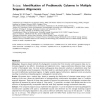14 search results - page 1 / 3 » Multiple sequence alignment based bootstrapping for improved... |
ICASSP
2010
IEEE
13 years 3 months ago
2010
IEEE
We investigate incremental word learning with few training examples in a Hidden Markov Model (HMM) framework suitable for an interactive learning scenario with little prior knowle...
ACL
2010
13 years 2 months ago
2010
Semi-supervised word alignment aims to improve the accuracy of automatic word alignment by incorporating full or partial manual alignments. Motivated by standard active learning q...
EVOW
2010
Springer
13 years 8 months ago
2010
Springer
A challenging problem in bioinformatics is the detection of residues that account for protein function specificity, not only in order to gain deeper insight in the nature of functi...
ALMOB
2008
13 years 4 months ago
2008
Motivation: Sequence-based methods for phylogenetic reconstruction from (nucleic acid) sequence data are notoriously plagued by two effects: homoplasies and alignment errors. Larg...
TCBB
2008
13 years 4 months ago
2008
When aligning biological sequences, the choice of scoring scheme is critical. Even small changes in gap penalties, for example, can yield radically different alignments. A rigorous...

